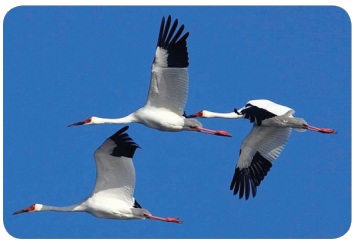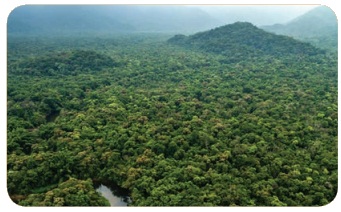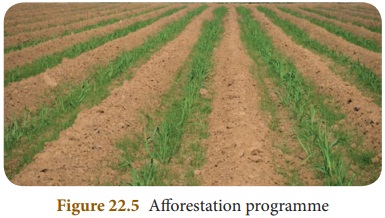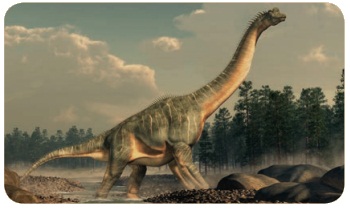Science : Chapter 22 : Conservation of Plants and Animals
TEXTBOOK EXERCISES
I. Choose the best answer.
1. The plants found in a particular area are known as ________
a) fauna
b) flora
c) endemic
d) rare
[Answer: (c) endemic]
2. Deforestation means ______
a) cleaning of forest
b) to grow plants
c) to look after plants
d) None of these.
[Answer: (d) None of these]
3. The Red Data Book gives a list of _________
a) endemic species
b) extinct species
c) natural species
d) None of these
[Answer: (d) None of these]
4. Insitu conservation is________
a) off site conservation
b) on site conservation
c) Both a and b
d) None of these
[Answer: (b) on site conservation]
5. Wildlife Protection Act was implemented in ________
a) 1986
b) 1972
c) 1973
d) 1971
[Answer: (b) 1972]
II. Fill in the blanks.
1. WWF stands for World Wildlife Fund.
2. The animal found in a particular area is known as endemic.
3. Red Data Book is maintained by International Union for conservation of Nature.
4. Mudhumalai Wildlife Sanctuary is located in Nilgiris district.
5. March 3 is observed as ‘World Wildlife Day’
III. Match the following.
1. Gir National Park – Madhya Pradesh
2. Sundarabans National Park – Uttara khand
3. Indira Gandhi National Park – West Bengal
4. Corbett National Park – Gujarat
5. Kanha National Park – Tamil Nadu
Answer:
1. Gir national park – Gujarat
2. Sundarabans National Park – West Bengal
3. Indira Gandhi National Park – Tamil Nadu
4. Corbett National Park – Uttarangal
5. Kanha National Park – Madhya Pradesh
IV. Answer very briefly.
1. What is global warming?
Answer: Gases methane and carbon dioxide accumulating in the atmosphere and trap the heat energy inside the atmosphere leading to increase in temperature is called Global warming.
2. What is known as extint species?
Answer: Species which no longer exist on Earth are called extinct species.
3. Give few example for extinct species.
Answer: Dinosaurs and Dodo are examples of extinct species.
4. Name two endangered animals.
Answer:
(i) Snow Leo pard,
(ii) Asiatic Lion.
5. What is IUCN?
Answer: IUCN – International Union for Conservation of Nature. It is an international organization working in the field of Nature Conservation and sustainable use of Natural Resources.
V. Answer briefly.
1. What is biosphere reserve?
Answer:
(i) Biosphere is a protected area where human population also forms the part of the system.
(ii) The area of these places will be around 5000 square kilometers. They conserve the eco system, species and genetic resources. These areas are set up mainly for economic development.
2. What is tissue culture?
Tissue culture is a technique of growing plant cells, tissues, organs, seeds or other plant parts in a sterile environment on a nutrient medium.
3. What is endangered species? Give two examples.
Answer:
(i) An endangered species is an animal or a plant that is considered to be at the risk of extinction.
(ii) It means that there are only few of them left on the Earth and soon they might extinct.
(iii) Snow leopard, Bengal tiger, Asiatic lion, Purple frog and Indian giant squirrel are some of the endangered animals in India.
4. Write the advantages of the Red Data Book.
Answer:
(i) It helps to evaluate the population of a particular species.
(ii) The data given in this book can be used to evaluate the species at the global level.
(iii) The risk of a species becoming globally extinct can be estimated with the help of this book.
(iv) It provides guidelines for implementing protective measures for endangered species.
5. Mention four main reasons for the conservation of forests.
Answer:
(i) According to WWF (World Wildlife Fund) there has been ‘60% decrease in the size of population of animals, birds, fish, reptiles and amphibians over the past 40 years.
(ii) In order to leave something for the future generation, we need to conserve it now.
(iii) Conservation is the protection, preservation, management of wildlife and natural resource such as forest and water.
(iv) Conservation of biodiversity helps us to protect, maintain and recover endangered animals and plant species.
6. What do you understand by the term bio magnification?
Answer:
(i) Bio-magnification is the increase in contaminated substances due to the intoxicating environment.
(ii) The contaminants might be heavy metals such as mercury, arsenic, and pesticides such as polychlorinated biphenyls and DDT (Dichloro Diphenyl Trichloro ethane).
(iii) These substances are taken up by the organisms through the food they consume.
(iv) When the organisms in the higher food chain feed on the organisms in the lower food chain containing these toxins, these toxins get accumulated in the higher organisms.
7. What is PBR?
Answer:
(i) People’s Biodiversity Register is a document which contains comprehensive information on locally available bio-resources including landscape and demography of a particular area or village. ,
(ii) Bio-resources mean plants, animals and microorganisms or parts thereof, their genetic material and by-products with actual or potential use or value.
(iii) A Biodiversity Management Committee is set up in each local body which prepares the People’s Biodiversity Registers with the guidance and technical support of National Biodiversity Authority and the State Biodiversity Boards.
(iv) Preparation of this register promotes conservation, preservation of habitats and breed of animals and gathering of knowledge relating to biological diversity.
(v) The register entails a complete documentation of biodiversity in the area related to the plant, food source, wildlife, medicinal source, traditional knowledge etc.
VI. Answer in detail.
1. What is deforestation? Explain the causes and effects of deforestation.
Answer:
Destruction of forests in order to make the land available for different uses is known as deforestation.
Causes of Deforestation :
(i) Fires and floods are the natural causes for deforestation.
(ii) Human activities are responsible for deforestation include agricultural expansion, cattle breeding, illegal logging, mining, oil extraction, dam construction and infrastructure development.
a) Agricultural Expansion :
(i) With increasing population, there is an overgrowing demand for food production.
(ii) Hence, large amount of trees are chopped down for crops and for cattle grazing.
b) Urbanization :
(i) Increase in population needs the expansion of cities.
(ii) More land is needed to establish housing and settlement.
(iii) Requirements like construction of roads, development of houses, mineral exploitation and expansion of industries also arise due to urbanisation.
(iv) Forests are destroyed to meet all these needs.
c) Mining:
(i) Mining of coal, diamond and gold require a large amount of forest land.
(ii) Large number of trees are cut down to clear the forest area. The waste that comes out from mining pollutes the environment and affects the nearby plants.
d) Construction of dams :
To provide water supply to the increasing population, large size dams are constructed. Hence, a great extend of forest area is being cleared.
e) Timber Production :
(i) Wood-based industries like paper, match-sticks, furniture need a substantial amount of wood supply.
(ii) Wood is the most commonly used fuel, thus, a large number of trees are being cut down for fuel supplies.
(iii) Illegal wood cutting is the main reason for the destruction of some valuable plants.
f) Forest fire :
(i) Forest fire be caused by humans, accidents or natural factors.
(ii) Forest fires wipe out thousands of acres of forest land each year all over the world. This has tremendous effects on biodiversity and the economy as well.
g) Cyclones:
Cyclones destroy the trees on a massive scale.
Effects of Deforestation :
a) Extinction of species :
Deforestation has resulted in the loss of many wonderful species of plants and animals and many are on the verge of extinction.
b) Soil Erosion :
(i) When the trees are cut down, soils are exposed to the Sun’s heat.
(ii) Extreme temperature of the summer dries up the moisture and makes the nutrients to evaporate. It also affects the bacteria that helps in the breakdown of organic matter.
c) Water cycle :
When trees are cut down, the amount of water vapour released decreases for transpiration and hence there is a decrease in the rainfall.
d) Floods:
When the trees are cut down, the flow of water is disrupted and it leads to flooding.
2. Discuss the advantages of in-situ and ex-situ conservation.
Answer:
Advantages of In-situ conservation :
(i) Species can be adapted to their habitat.
(ii) Species can interact with each other.
(iii) Natural habitat is maintained.
(iv) It is less expensive and easy to manage.
(v) Interests of indigenous people are protected.
Advantages of Ex-situ conservation :
(i) It prevents the decline of species.
(ii) Endangered animals can be breeded in these ways.
(iii) Threatened species are breeded and released in natural environment.
(iv) It is useful for conducting research and scientific work.
3. Write about the types of conservation.
Answer: Conservation is the protection, preservation, management of wildlife and natural resource such as forest and water.
Types :
In-situ conservation :
It is conservation of living resources within the natural ecosystem in which they occur.
a) National Parks :
(i) It is an area which is strictly reserved for the betterment of the wildlife.
(ii) Here, activities like forestry, grazing or cultivation are not permitted.
(iii) Eg.: Guindy National Park in Chennai district.
b) Wildlife sanctuaries :
(i) A sanctuary is a protected area reserved for the conservation of animals only.
(ii) Human activities like harvesting of timber, collection of forest products and private ownership rights are allowed here.
(iii) Controlled interference like tourist activity is also allowed.
c) Biosphere reserves :
(i) It is a protected area where human population also forms the part of the system.
(ii) The area of these places will be around 5000 square kilometers.
(iii) They conserve the eco system, species and genetic resources.
(iv) Eg. : These areas are set up mainly for economic development.
Ex-situ Conservation :
It is the conservation of wildlife outside their habitat. Establishing zoos and botanical gardens, conservation of genes, seedling and tissue.
a) Botanical gardens :
(i) It is a place where flowers, fruits and vegetables are grown.
(ii) These places provide a healthy and calm environment.
b) Zoological parks :
(i) Zoological parks are the areas where wild animals are conserved.
(ii) In India there are about 800 zoological parks.
c) Tissue Culture :
It is a technique of growing plant cells, tissues, organs, seeds or other plant parts in a sterile environment on a nutrient medium.
d) Seed bank:
The seed bank preserves dried seeds by storing them in a very low temperature.
e) Cryo Bank :
It is a technique by which a seed or embryo is preserved at a very low temperature.
4. Write a note on Blue Cross.
Answer:
(i) Blue Cross is a registered animal welfare charity in the United Kingdom, founded in 1897 as ‘Our Dumb Friends League’.
(ii) The vision of this charity is that every pet will enjoy a healthy life in a happy home.
(iii) The charity provides support for pet owners who cannot afford private veterinary treatment, helps to find homes for unwanted animals, and educates the public in the responsibilities of animal ownership.
(iv) Captain V. Sundaram founded the Blue Cross of India, the largest animal welfare organization of Asia in Chennai in the year 1959.
(v) He was an Indian pilot and animal welfare activist. Now, Blue Cross of India the country’s largest animal welfare organizations and it runs several animal welfare events like pet adaptation and animal right awareness.
(vi) Blue Cross of India has received several international and national awards.
(vii) This organization is entirely looked after by volunteers.
(viii) The main office is located at Guindy, Chennai, with all amenities like hospitals, shelters, ambulance services and animal birth controls, etc.
(ix) Activities of the organization include, providing shelters, re-homing, adoption, animal birth control, maintaining hospitals and mobile dispensary and providing ambulance services.
VII. Higher Order Thinking Questions.
1. Is it possible to find dinosaurs today? Why?
Answer:
(i) No. It is not possible to find Dinosaurs today since they have become extinct.
(ii) The reasons may be shortage of food, space or climate changes.
2. Animals are affected by deforestation. How?
Answer:
(i) Deforestation involves destruction of forests by man to make the lend available for different uses.
(ii) When forests are destroyed, the wild animals living there are left homeless.
(iii) They start moving out in search of shelter.
(iv) Since animals start moving out the food chains are also affected and animals cannot find food also.
(v) They also get isolated from their groups and may be killed by accidents or hunted.
3. Why did the numbers of tiger and black buck decrease?
Answer:
(i) The number of Black buck and Tigers have decreased due to excessive hunting, Deforestation and habitat degradation.
(ii) Tigers are also facing problems of prey depletion since the number of deers and other herbivores are decreasing due to disappearance of forests.
Student Activities
Activity 1Collect information about a nearby forest in your area and find out the rare species of plants and animals found there. Collect some pictures of plants and animals which you do not find around you and prepare an album.
Activity 2
Discuss about afforestation in the class and write a brief report on your discussion.
Activity 3
Observe the important days related to conservation of nature. Also organise a ralley on protecting forest.
Activity 4
Observe the following days in your school
World Forest Day – March 21
World Water Day – March 22
Environmental Day – June 5
World Nature Conservation Day -July 28
Ozone Day – September 16
Activity 5
Collect as many pictures of wild plants and wild animals as possible. Prepare a poster showing the endangered species separately.
Activity 6
Find out the national parks and wildlife santuaries in Tamil Nadu. Visit those places and collect more information about them.
Chipko Movement is primarily a forest conservation movement. The word ‘Chipko’ means ‘to stick’ or ‘to hug’. Sunderlal Bahuguna was the founder of this movement. It was started in 1970s with the aim of protecting and conserving trees and preserving forest from being destroyed.
Long distance travel by birds to escape severe environmental conditions is called migration. Many birds and many other animals migrate long distances during unfavourable season. Siberian Crane migrates from Siberia to India during winters to escape harsh conditions in Siberia and to get comfortable conditions and food in India. Siberian crane, on an average can travel 200 miles in a single day.

Amazon forest is the largest rain forest in the world, located in Brazil. It covers 6000000 square km. It helps to stabilize the earth’sclimate and slow global warming by fixing Co2, and producing 20% of the world’s oxygen in the process. It has about 390 billion trees. It is the lungs of the planet.

The term social forestry was first used in 1976 by the then National Commission on Agriculture, Government of India. It means the management and protection of forests and afforestation on barren land with the purpose of helping the environment, social and rural development. It is to raise the plantations thereby reducing the pressure on the traditional forest area.

Wangari Maathai founded the Green Belt Movement in Kenya in the year 1977.GBM has planted over 51 million trees in Kenya. She was awarded the Nobel Peace Prize for 2004.

Each year, 22nd May is celebrated as World Biodiversity Day. Biodiversity is a term used to describe the different plants, animals,marine life, microorganisms, insects, habitats, ecosystem etc. that make our planet so unique and so fascinating.
Yeoman Butterfly has been declared state butterfly of Tamil Nadu. This species is endemic to WesternGhats. It is among 32 butterfly species found in Western Ghats.

At one time Dinosaur, ferns and some gymnosperms were wide spread on the earth. They disappeared from the earth, may be due to shortage of space and food or due to climatic change

Planting the native trees like Neem tree, Umbrella tree and Banyan tree in our surrounding will be helpful for the animals. Many birds and animals find shelter in those trees.
World Wild life Day is observed on March 3rd every year.
The oldest zoo is Schoenbrunn Zoo in Vienna, established in the year 1759. In India the first Zoo was established in Barrachpur in the year 1800.
More to know
Dr. K. Sakhila Banu, a scientist from Texas A & M University, USA has found out that the water contaminated by chromium metal induces infertility in female species and also causes oxidative stress in the human placenta which could affect the growth of the baby. She is from Pudupattinam village in Ramnad district, Tamil Nadu.
Blue cross was founded to care for working horses on the streets of London, UK. It opened its first animal hospital, in Victoria, London, on 15May 1906.














